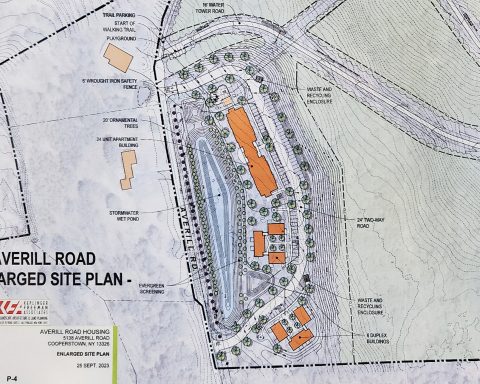Village Reviews Application from Templeton Foundation Averill Road Project Back for Second Look By DARLA M. YOUNGSCOOPERSTOWN Following two lawsuits and 90 minutes of oral argument in Madison County Supreme Court in April, Templeton Foundation has resubmitted plans for its proposed multi-residential project on Averill Road and is once again seeking the issuance of a Special Use Permit by the Cooperstown Board of Trustees.…
Douglas Zamelis
Averill Road Case To Be HeardNext Thursday By DARLA M. YOUNGSWAMPSVILLE On Thursday, March 23, Madison County Supreme Court Justice Hon. Patrick J. O’Sullivan issued a temporary restraining order preventing Templeton Foundation or its agents from any further on-site work at the foundation’s property on Averill Road in the Village of Cooperstown. An order to show cause is a court order or the demand of a judge requiring a party to justify or explain why the court should or should not grant a motion or a relief,…
Letter from Paul Lord Zamelis Piece Buried Last Week Please help me here. I want to thank you for publishing lawyer Zamelis’ letter in the March 16 edition of “The Freeman’s Journal,” but I also want to understand why that news, if it is true, was buried on page 8. It appears Zamelis’ story is the most important local news found in that edition of “The Freeman’s Journal.” Why is there no mention of the story on page 1? Will…
Second Lawsuit FiledRegarding Averill Road By DARLA M. YOUNGSCOOPERSTOWN After submitting a “Partial Observer” commentary to “The Freeman’s Journal” and “Hometown Oneonta” last week regarding concerns about work being done on the Templeton Foundation’s Averill Road property, environmental lawyer Douglas H. Zamelis has filed a second lawsuit against the Village of Cooperstown Board of Trustees, the Village of Cooperstown zoning enforcement officer and Templeton Foundation itself. On January 18, Zamelis had filed a petition in the Madison County Supreme Court…
The Partial Observer by Douglas Zamelis, Esq. What Are We Doing? Activity atAverill Road Property Questioned It’s common knowledge Templeton Foundation seeks to build a large housing development on its property on Averill Road in the Village of Cooperstown. The village zoning law requires a special permit prior to construction and state law requires that prior to granting approval, the Board of Trustees must assess and mitigate the project’s environmental impacts. Because the project is in an historic district and…


